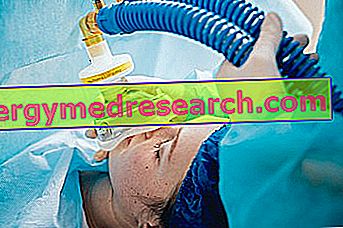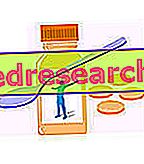Generality
Benign prostatic hypertrophy is a term used improperly as a synonym for benign prostatic hyperplasia or prostate adenoma.
It is a uniquely male disorder characterized by an increase in prostate size.

The most frequent complication of benign prostatic hypertrophy is the difficulty in urination . In turn, this disorder causes progressive hypertrophy of the bladder muscle (increase in cell thickness and tissue) and the consequent instability or weakness (atony).
Benign prostatic hyperplasia increases the levels of prostate specific antigen and the degree of inflammation. However, it is not a cancerous form .
Adenomatous prostate growth begins at approximately 30 years of age. 50% of men show the first signs at 50 years. It becomes clinically significant in 40-50% of males.
Among the "over 50", benign prostatic hyperplasia is one of the ten most relevant and economically incisive diseases (statistical value observed in the USA).
Causes
The causes of benign prostatic hypertrophy often include the presence of a set of risk factors:
- Third age: the disease is linked to seniority, probably due to fibrosis and weakening of the prostate muscle tissue necessary to expel the secreted fluids (which contain predisposing molecules). Lesions of prostatic muscle fibers (inevitable with old age) are not easily repairable; the tissue is replaced by non-contractile collagen fibers, jeopardizing the expulsion of liquids and favoring "stagnation".
- Androgen hormones: they are the male sex hormones produced mainly by the testicles. Statistically, castrated men show a lower incidence of benign prostatic hyperplasia. This suggests that the androgenic hormones play a predisposing role. However, exogenous testosterone administration is NOT always linked to the onset of the disease.
- Dihydrotestosterone (DHT): is a metabolite of testosterone synthesized in the prostate. It is part of the composition of the "fluids secreted by the prostate" mentioned in point 1. An excessive concentration of DHT favors the risk of hyperplasia. By inhibiting the cellular enzyme (called 5α-reductase) at the base of testosterone-DHT conversion, a reduction in prostate volume and related symptoms is achieved.
- Diet : some studies indicate that nutrition can influence the development of benign prostatic hypertrophy. However, confirmation of the results requires further investigation.
Nutritional Implications
Some studies carried out in China suggest that excessive protein intake, especially of animal origin, could be a risk factor for benign prostatic hyperplasia.
In these researches, men over 60 years old living in rural areas and with a predominantly plant-based diet have shown an incidence of benign prostatic hyperplasia that is LOWER than in citizens who consume more animal protein.
A study carried out on Japanese men naturalized in America revealed a strong association between benign prostatic hypertrophy and ethyl alcohol intake. In the same project, the correlation between the pathology and consumption of beef was weaker.
In a prospective study carried out in the United States ( Health Professionals Follow-up Study ), the researchers showed a modest association between severe benign prostatic hypertrophy and excessive protein and total calorie intake, but not fat.
There is also epidemiological evidence linking prostate adenoma with the metabolic syndrome. The prevention of: obesity, hyperglycemia or type 2 diabetes mellitus, hypertriglyceridemia, LDL hypercholesterolemia and hypertension, is to be considered a protective factor against benign prostate adenoma.
Diet
The diet for prostatic hypertrophy is preventive in nature.
The key points of this food system are:
- Abolition of alcohol or global reduction up to the limit allowed by the guidelines.
- Nutritional balance and energy intake within normal limits; in case of overweight, a calorie reduction is necessary for weight loss.
- Moderation of the global protein component.
- Protein distribution: 2/3 of plant origin and 1/3 of animal origin.
Alcohol
Ethyl alcohol is a molecule produced by Saccaromiceti yeasts during carbohydrate fermentation.
The human organism is NOT able to use it for energy purposes. The liver converts it into fatty acids that are deposited inside and in adipose tissue. For this reason, excess alcohol correlates with fatty liver and overweight.
Ethilism also causes psychophysical dependence and systemic intoxication of severity related to the extent of the abuse.
The toxic effects on tissues mainly concern: the brain, the mucosa of the digestive tract and the liver. Ethyl alcohol is also harmful to the developing fetus in the pregnant woman.
Universally, moderate use is recommended. Research institutions recommend different levels based on age, sex and special physiological or pathological conditions.
Assuming that the only harmless dose of ethyl alcohol is 0, we could state the following:
"A healthy adult male should not exceed 2-3 alcoholic units per day, preferably to be consumed at main meals.
An alcoholic unit corresponds to a 125ml glass of wine or a 330ml blonde beer or a 40ml alcohol. The quantity of alcohol contained in an alcoholic unit is approximately 12g.
Those who wish to prevent benign prostatic hyperplasia should limit themselves to taking the recommended daily dose; however, a full-blown diagnosis involves the total abolition of alcohol ".
Calories and Overweight
Overweight can be defined as an excess of adipose tissue, which increases body weight beyond normal limits.
Adipose tissue is an energy reserve of fat, which increases with excess calories; these are provided by: lipids, glucides, proteins and alcohol.
Overweight is promoted by a sedentary lifestyle, nutritional imbalance, alcoholism and junk food consumption.
The most serious forms of overweight are defined as obesity. It is a risk factor for many metabolic pathologies, namely: hyperglycemia, LDL cholesterol (bad), triglyceridemia and arterial hypertension.

The excess weight is estimated with different methods and, in ordinary people, above all thanks to the calculation of the body mass index (BMI; in English BMI). The overweight proper is evidenced by a score equal to or greater than 25; from 30 onwards the condition is called obesity.
To combat overweight and reduce the risk of benign prostatic hypertrophy, it is necessary to apply lifestyle adjustments; for example:
- Introduce fewer calories than those that allow you to maintain constant weight.
- Balance the diet, especially avoiding excess carbohydrates and fats.
- Eliminate junk foods.
- Eliminate alcohol abuse.
- Perform physical activity every day.
Protein
Proteins are energy macronutrients found in most foods, both animal and vegetable.
The "bricks" that compose them (amino acids) perform many biological functions: plastic, bioregulator, energy, etc.
On the other hand, a long-term protein excess can trigger side effects, especially when foods are of animal origin (meat, milk and dairy products, fishery products, eggs).
The proteins are not all the same and are cataloged according to the biological value. This parameter examines the content of essential amino acids, or those "bricks" that the human organism is not able to produce independently.
In general, the most biologically valuable proteins are animal ones (meat, fishery products, eggs, milk and derivatives). In the past, animal protein consumption of AT LEAST 1/3 of the total was recommended. Today, the collective trend has become that of abuse.
Moreover, among the foods of vegetable origin there are "exceptions", ie foods that contain proteins with high biological value. Some examples are soy and certain marine algae, which have an extremely valuable amino acid profile.
Among other things, the vegetable peptides of the most common foods (for example cereals and legumes such as: rice and peas, wheat and beans etc.) can be associated with each other offsetting their biological value.
By varying the supply it is possible to obtain all the essential amino acids in the right quantities and without resorting to large portions of meat, cheese, etc.
To conclude, those of animal origin are extremely nutritious foods; on the other hand, excess should also be considered potentially harmful for benign prostatic hypertrophy. In the Western diet, too large and frequent portions are consumed, which can be a risk factor for the onset of this disorder.
The recommended protein limit is different according to age, to any special physiological conditions and to the research organization that disseminates the recommendation.
Respecting what is specified in the table below, it is possible to avoid the protein excess of animal origin.
| FOOD TYPE | CONSUMPTION FREQUENCY | PORTION |
| Fresh Meats | 2 times a week | 100g |
| Preserved meats | 1-2 times a week | 50g |
| Fresh Fish Products | 2 times a week | 150g |
| Preserved Fish Products | 1-2 times a week | 50g |
| Whole eggs | 1-2 times a week | 50g |
| Milk and Yogurt | Twice daily | 125-150ml |
| Fresh Cheeses | 1-2 times a week | 100g |
| Aged Cheeses | 1-2 times a week | 50g |
NB . Portions of meat, fish, eggs and cheese are to be considered WHOLE if used as the main dish of the meal (for example, the second dinner plate).
On the contrary, they should be halved if they have a less important function (for example, a small dish after the first course at lunch).



